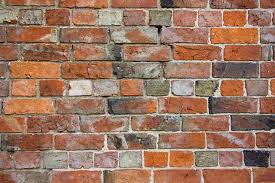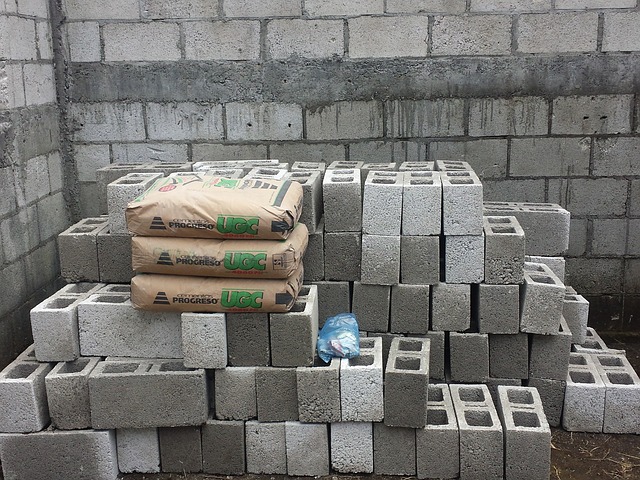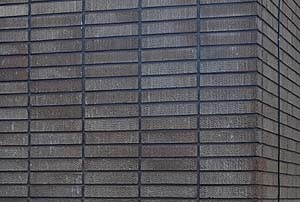Brick sizes
Contents |
[edit] Introduction
There are many different types of brick available, and it is important to both choose your bricks wisely and also check their dimensions to ensure they fit with the design layout.
This article presents a size guide for some of the most commonly-used bricks.

|

|

|
[edit] What size are standard bricks?
The standard co-ordinating size for brickwork is 225 mm x 112.5 mm x 75 mm (length x depth x height). This includes 10 mm mortar joints, so the standard size of a brick itself is 215 mm x 102.5 mm x 65 mm (length x depth x height).
This gives a ratio of 3:2:1, meaning that:
- With a standard mortar joint of 10 mm, a repeating unit of bricks laid in a stretcher bond will be 225 mm lengthwise and 75 mm in height.
- If bricks are laid cross-wise, two 102.5 mm depths plus two mortar joints gives the same repeating unit as the length of one brick plus one mortar joint, i.e. 225 mm.
- If they are laid height wise, three 65 mm heights plus three mortar joints gives the same repeating unit as the length of one brick plus one mortar joint, i.e. 225 mm.
This makes it straight-forward to create complex patterns of bricks within the standard co-ordinating size. See Types of brick bonding for more information.
60 standard bricks laid in a stretcher bond (lengthwise) are required for every square meter of wall.
[edit] What sizes are non-standard bricks?
A list of common brick sizes and their characteristics is set out below:
| Type | Characteristics | Imperial length x depth x height | Metric length x depth x height (mm) |
| Blocks | Constructed using concrete or cement. They may include a hollow core to make them lighter and to improve their insulation. | 440 x (varies) x 215 | |
| Modular | Commonly used for the construction of buildings and homes. | 7-5/8" x 3-5/8" x 2-1/4" | 194 x 92 x 57 |
| Jumbo modular | 7-5/8" x 3-5/8" x 2-3/4" | 194 x 92 x 70 | |
| Queen | Slightly smaller and more cost effective than a modular brick. | 9-5/8" x 3-1/8" x 2-3/4" | 244 x 79 x 70 |
| King | 9-5/8" x 2-3/4" x 2-5/8" | 244 x 76 x 67 | |
| Engineer | Used where strength and water/frost resistance are required. Very sturdy and reliable to use. | 7-5/8" x 3-5/8" x 2-13/16" | 194 x 92 x 71 |
| Closure | Used to finish off a wall, especially at the corners | 7-5/8" x 3-5/8" x 3-5/8" | 194 x 92 x 92 |
| Norwegian | Substantial bricks that can be used in load-bearing walls while still looking good. They have a natural beauty to them. | 11-5/8" x 3-5/8" x 2-13/16" | 295 x 92 x 71 |
| Monarch | Commonly used for long stretches of wall and are very strong. | 15-5/8" x 3-5/8" x 3-5/8" | 397 x 92 x 92 |
| Utility | Very versatile and can be used for a range of construction projects. | 11-5/8" x 3-5/8" x 3-5/8" | 295 x 92 x 92 |
| Norman | These are classic industrial bricks for construction projects and commonly come in red or white. | 11-5/8" x 3-5/8" x 2-1/4" | 295 x 92 x 57 |
| Roman | 11-5/8" x 3-5/8" x 1-5/8" | 295 x 92 x 41 | |
| Quad | 7-5/8 x 3-5/8" x 7-5/8" | 194 x 92 x 194 | |
| Danish hand mould | 7-5/8" x 3-5/8" x 2-1/4" | 194 x 92 x 57 | |
| Meridian | 15-5/8" x 3-5/8" x 3-5/8" | 397 x 92 x 92 | |
| Ambassador | 15-5/8" x 3-5/8" x 2-1/4" | 397 x 92 x 57 |
Note, there may be some variation in these sizes through history and from one supplier to another.
[edit] What are special bricks?
Other than the standard rectangular bricks, a number of special shapes exist for particular circumstances:
- Radial, tapered or arch bricks.
- Angle and cant bricks that form returns and chamfers.
- Bullnose bricks with rounded corners.
- Capping and coping bricks.
- Cill bricks.
- Plinth bricks.
- Slip bricks (thin bricks that can be used for cladding).
- Soldier bricks, that form returns for soldier courses.
Bricks can also be cut or hand made to size.
This article was originally created by --Specified
It has subsequently been edited by others - See full history for more information.
[edit] Related articles on Designing Buildings
IHBC NewsBlog
Images from inside a Grade II listed hotel show the scale of its collapse
The Corbett Arms in Tywyn has fallen into serious disrepair.
Old Sarum fire in listed (& disputed) WW1 Hangar - Wiltshire Council has sought legal advice after fire engulfed a listed First World War hangar that was embroiled in a lengthy planning dispute.
UK Antarctic Heritage Trust launches ‘Virtual Visit’ website area
The Trust calls on people to 'Immerse yourself in our heritage – Making Antarctica Accessible'
Southend Council pledge to force Kursaal owners to maintain building
The Council has pledged to use ‘every tool in the toolbox’ if urgent repairs are not carried out.
HE’s Research Magazine publishes a major study of the heritage of England’s suburbs
The article traces the long evolution of an internal programme to research 200 years of suburban growth
IHBC Context 183 Wellbeing and Heritage published
The issue explores issues at the intersection of heritage and wellbeing.
SAVE celebrates 50 years of campaigning 1975-2025
SAVE Britain’s Heritage has announced events across the country to celebrate bringing new life to remarkable buildings.
IHBC Annual School 2025 - Shrewsbury 12-14 June
Themed Heritage in Context – Value: Plan: Change, join in-person or online.
200th Anniversary Celebration of the Modern Railway Planned
The Stockton & Darlington Railway opened on September 27, 1825.
Competence Framework Launched for Sustainability in the Built Environment
The Construction Industry Council (CIC) and the Edge have jointly published the framework.
















Comments
[edit] To make a comment about this article, click 'Add a comment' above. Separate your comments from any existing comments by inserting a horizontal line.
Really helpful to have lots of different brick sizes in a single article.